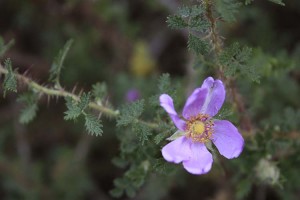I grew this fiercely thorny rose, Rosa minutifolia, for over a decade. With wild-rose-pink flowers barely two inches across, its petals were crinkled and delicate, but the blooms were never particularly stunning when compared to the buxom, botoxed blooms of typical garden roses. The leaves were tiny to the point of almost being non-existent, and I’ve already mentioned the incredible number of thorns that made this just about the prickliest thing I’ve ever dealt with. (The only similarly thorny roses I can think of are a few heirloom moss roses like Alfred de Dalmas that I grew in my early teen rose-growing years.) So spiny is it that one of its early collectors proposed an alternate name for it: Rosa horrida. (Check out the fascinating tale of its discovery by Barbara Ertter here.)
In the end, I think I grew it partly because of its weirdly cool thorniness and its interesting story, but also because of its artificial, political rarity. In the United States, this rose is found only as a small island population along the Mexican border on Otay Mesa, here in San Diego County. This extreme rarity has placed it on California’s endangered species list. Skip south into Mexico a few dozen miles, however, and the plant begins to become a fairly common member of the chaparral plant community, forming great mounded thickets three to four feet high and many feet across. The notion that the plant is particularly rare is an artifact of national boundaries. Erase the US-Mexico border, and Rosa minutifolia becomes a mainstay of part of the pan-Californian ecosystem.
I find that to be a weird little mental game: Is the plant rare or not? What odd things do political boundaries do to how we understand the natural world that those boundaries are drawn over? Does that mean that it’s crazy to call this an endangered plant?
To that last question, I’ll answer that we really should consider it a plant to protect. We need to preserve what’s left of the diversity that remains in the world. If the plant goes extinct in California, it’s gone from California. Never mind that it has cousins south of the border.
Borderlands, Continental Divide produced by The Cornell Lab of Ornithology from iLCP on Vimeo.
And these days the purely conceptual notion of a national border is turning into a physical reality, as the ginormous border fence project turns the United States into a freakish zoo exhibit behind bars as this video produced by the Cornell Lab of Ornithology shows. (I also did a brief post related to all this recently, on the destruction of Smuggler’s Gulch.) When the only know U.S. population of this plant is further isolated from its southern kin, it becomes all the more desperate to preserve what little we have left.
When we were preparing the back yard for a small room addition we needed to move a few plants out of the way. My Rosa minutifolia was one of them. Used to near-desert conditions, the plant shoots down roots far into the ground, maybe even 20 feet deep. I guess I didn’t get enough of the roots, not to mention the fact that the transplant took place in the high heat of summer. The plant declined and then died over the course of a couple months.
I see the plant here and there. A native plant sale might have a few plants. The Tree of Life Nursery stocks it. Botanical gardens sometimes have a little thicket of it (or a massive thicket of it as is the case at Rancho Santa Ana Botanical Garden where “five rooted cuttings planted…in 1954 had become ‘one large tangled mass’ nearly 30 feet across by 1982” [ source ]). All these photos are from the Huntington’s Desert Garden, where the rose grows alongside cactus and other things that make its spininess look right at home.
I get nostalgic whenever I see it. My little plant, which was set in awful, dense, dry soil in a much too shady spot, never grew or flowered much. Nipping at the dead branches kept it from forming a Rosa horrida thicket. But I continued to coddle it for whatever reasons any of us coddle interesting, under-performing plants. And one of these days I wouldn’t be surprised if I plant another little thicket of it.



